Acta Chimica Sinica ›› 2022, Vol. 80 ›› Issue (8): 1203-1216.DOI: 10.6023/A22030136 Previous Articles
Review
投稿日期:2022-03-29
发布日期:2022-09-01
通讯作者:
韩璐
作者简介: |
邓权政, 同济大学化学科学与工程学院2019级在读博士生, 本科毕业于同济大学, 现主要从事孔材料的电子显微学结构解析研究. |
 |
毛文婷, 2015年获得东华大学理学学士学位, 2021年获得上海交通大学(导师韩璐教授)理学博士学位. |
 |
韩璐, 同济大学化学科学与工程学院教授, 博士生导师. 2006年获上海交通大学理学学士学位, 2010年及2011年分别获得斯德哥尔摩大学及上海交通大学博士学位, 2011年入职上海交通大学, 2017年加入同济大学. 获2013年度全国优秀博士学位论文奖, 2014年度教育部自然科学奖一等奖(第二完成人), 2019年受自然科学基金优秀青年基金资助. 主要研究方向为介观结构材料的合成及电子显微学结构研究. |
基金资助:
Quanzheng Denga, Wenting Maob, Lu Hana( )
)
Received:2022-03-29
Published:2022-09-01
Contact:
Lu Han
Supported by:Share
Quanzheng Deng, Wenting Mao, Lu Han. Structural Solution of Porous Materials on the Mesostructural Scale by Electron Microscopy[J]. Acta Chimica Sinica, 2022, 80(8): 1203-1216.


























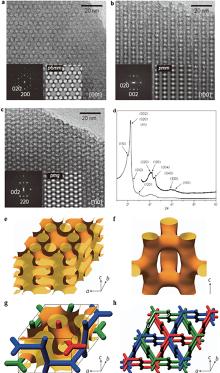

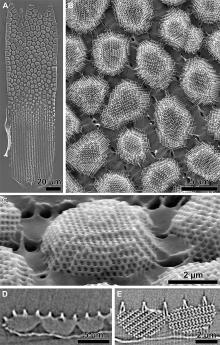

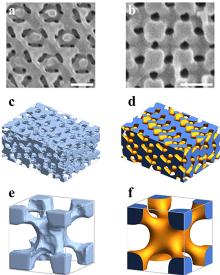

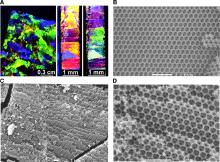

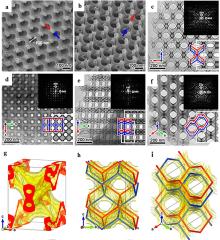

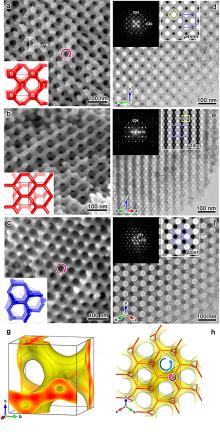



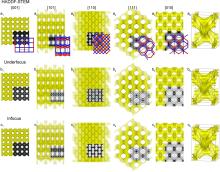

| [1] |
Kresge, C. T.; Leonowicz, M. E.; Roth, W. J.; Vartuli, J. C.; Beck, J. S. Nature 1992, 59, 710.
|
| [2] |
Huo, Q.; Margolese, D. I.; Ciesia, U.; Demuth, D. G.; Feng, P. Y.; Gier, T. E.; Sieger, P.; Firouzi, A. Chem. Mater. 1994, 6, 1176.
doi: 10.1021/cm00044a016 |
| [3] |
Wan, Y.; Zhao, D. Chem. Rev. 2007, 107, 2821.
doi: 10.1021/cr068020s |
| [4] |
Terasaki, O.; Liu, Z.; Ohsuna, T.; Shin, H. J.; Ryoo, R. Microsc. Microanal. 2002, 8, 35.
pmid: 12533202 |
| [5] |
Zhao, D.; Feng, J.; Huo, Q.; Melosh, N.; G. Fredrickson, H.; Chmelka, B. F.; Stucky, G. D. Science 1998, 279, 548.
pmid: 9438845 |
| [6] |
Inagaki, S.; Guan, S.; Ohsuna, T.; Terasaki, O. Nature 2002, 416, 304.
doi: 10.1038/416304a |
| [7] |
Che, S.; Liu, Z.; Ohsuna, T. Nature 2004, 429, 281.
doi: 10.1038/nature02529 |
| [8] |
Qiu, H.; Che, S. J. Phys. Chem. B 2008, 112, 10466.
doi: 10.1021/jp802615z |
| [9] |
Qiu, H.; Wang, S.; Zhang, W.; Sakamoto, K.; Terasaki, O.; Inoue, Y.; Che, S. J. Phys. Chem. C 2008, 112, 1871.
doi: 10.1021/jp709798q |
| [10] |
Zhao, D. Y.; Huo, Q. S.; Feng, J. L.; Chmelka, B. F.; Stucky, G. D. J. Am. Chem. Soc. 1998, 120, 6024.
doi: 10.1021/ja974025i |
| [11] |
Garcia-Bennett, A. E.; Che, S.; Tatsumi, T.; Terasaki, O. Chem. Mater. 2004, 16, 813.
|
| [12] |
Garcia-Bennett, A. E.; Kupferschmidt, N.; Sakamoto, Y.; Che, S.; Terasaki, O. Angew. Chem. Int. Ed. 2005, 44, 5317.
doi: 10.1002/anie.200500113 |
| [13] |
Xiao, C.; Fujita, N.; Miyasaka, K.; Sakamoto, Y.; Terasaki, O. Nature 2012, 487, 349.
doi: 10.1038/nature11230 |
| [14] |
Carlsson, A.; Kaneda, M.; Sakamoto, Y.; Terasaki, O.; Ryoo, R.; Joo, S. H. J. Electron. Microsc. 1999, 48, 795.
doi: 10.1093/oxfordjournals.jmicro.a023751 |
| [15] |
Gao, C.; Sakamoto, Y.; Sakamoto, K.; Terasaki, O.; Che, S. Angew. Chem. Int. Ed. 2006, 45, 4295.
doi: 10.1002/anie.200504114 |
| [16] |
Han, Y.; Zhang, D.; Chng, L.; Sun, J.; Zhao, L.; Zou, X. Nature Chem. 2009, 1, 123.
doi: 10.1038/nchem.166 |
| [17] |
Beck, J. S.; Vartuli, J. C.; Roth, W. J.; Leonowicz, M. E.; Kresge, C. T.; Schmitt, K. D.; Chu, C. T. W.; Olson, D. H.; Sheppard, E. W.; McCullen, S. B.; Higgins, J. B.; Schlenker, J. L. J. Am. Chem. Soc. 1992, 114, 10834.
doi: 10.1021/ja00053a020 |
| [18] |
Tüysüz, H.; Lehmann, C. W.; Bongard, H.; Tesche, B.; Schmidt, R.; Schüth, F. J. Am. Chem. Soc. 2008, 130, 11510.
doi: 10.1021/ja803362s pmid: 18671351 |
| [19] |
Kielman, T.; Asahina, S.; Schmitt, J.; Impéror-Clerc, M.; Terasaki, O.; Alfreason, V. Chem. Mater. 2013, 25, 4105.
doi: 10.1021/cm402635m |
| [20] |
Qiu, H.; Sakamoto, Y.; Terasaki, O.; Che, S. A. Adv. Mater. 2008, 20, 425.
doi: 10.1002/adma.200700809 |
| [21] |
Jin, C.; Han, L.; Che, S. Angew. Chem. Int. Ed. 2009, 48, 9268.
doi: 10.1002/anie.200904494 |
| [22] |
Aubert, T.; Ma, K.; Tan, K.; Winsner, U. Adv. Mater. 2020, 32, 1908362.
doi: 10.1002/adma.201908362 |
| [23] |
Xi, X.; Wu, D.; Han, L.; Yu, Y.; Su, Y.; Tang, W.; Liu, R. ACS Nano 2018, 12, 5436.
doi: 10.1021/acsnano.8b00576 |
| [24] |
Sakamoto, Y.; Kaneda, M.; Terasaki, O.; Zhao, D. Y.; Kim, J. M.; Stucky, G.; Shin, H. J.; Ryoo, R. Nature 2000, 408, 449.
doi: 10.1038/35044040 |
| [25] |
Huo, Q.; Margolese, D.; Ciesla, U.; Feng, P. Y.; Gier, T. E.; Sieger, P.; Leon, R.; Petroff, P. M.; Schüth, F.; Stucky, G. D. Nature 1994, 368, 317.
doi: 10.1038/368317a0 |
| [26] |
Zhao, D.; Feng, J.; Huo, Q.; Melosh, N.; Fredrickson, G. H.; Chmelka, B. F.; Stucky, G. D. Science 1998, 279, 548.
pmid: 9438845 |
| [27] |
Sakamoto, Y.; Díaz, I.; Terasaki, O.; Zhao, D. Y.; PérezPariente, J.; Kim, J.; Galen, D.; Stucky, G. D. J. Phys. Chem. B 2002, 106, 3118.
doi: 10.1021/jp014094q |
| [28] |
Miyasaka, K.; Han, L.; Che, S.; Terasaki, O.; Angew. Chem. Int. Ed. 2006, 45, 6516.
doi: 10.1002/anie.200601451 |
| [29] |
Han, L.; Sakamoto, Y.; Terasaki, O.; Li, Y.; Che, S. J. Mater. Chem. 2007, 17, 1216.
doi: 10.1039/b615209k |
| [30] |
Ma, Y.; Han, L.; Miyasaka, K.; Oleynikov, P.; Che, S.; Terasaki, O. Chem. Mater. 2013, 25, 2184.
doi: 10.1021/cm401294j |
| [31] |
Alfonso, E.; Garcia-Bennett, A. E.; Miyasaka, K.; Terasaki, O.; Che, S. Chem. Mater. 2004, 16, 3597.
doi: 10.1021/cm049398e |
| [32] |
Han, L.; Sakamoto, Y.; Che, S.; Terasaki, O. Chem.- Eur. J. 2009, 15, 2818.
doi: 10.1002/chem.200801688 |
| [33] |
Sakamoto, Y.; Terasaki, O. Solid State Sciences 2011, 13, 762.
doi: 10.1016/j.solidstatesciences.2010.04.006 |
| [34] |
Ohsuna, T.; Sakamoto, Y.; Terasaki, O.; Kuroda, K. Solid State Sci. 2011, 13, 736.
doi: 10.1016/j.solidstatesciences.2010.04.028 |
| [35] |
Sakamoto, Y.; Han, L.; Che, S.; Terasaki, O. Chem. Mater. 2009, 21, 223.
|
| [36] |
Che, S.; Lim, S.; Kaneda, M.; Yoshitake, H.; Terasaki, O.; Tatsumi, T. J. Am. Chem. Soc. 2002, 124, 13962.
doi: 10.1021/ja020854e |
| [37] |
Che, S.; Kamiya, S.; Terasaki, O.; Tatsumi, T. J. Am. Chem. Soc. 2001, 123, 12089.
pmid: 11724619 |
| [38] |
Han, L.; Xiong, P.; Bai, J.; Che, S. J. Am. Chem. Soc. 2011, 133, 6106.
doi: 10.1021/ja110443a pmid: 21469641 |
| [39] |
Sun, Y.; Ma, K.; Kao, T.; Spoth, K. A.; Sai, H.; Zhang, D.; Kourkoutis, L. F.; Elser, V.; Wiesner, U. Nat. Commun. 2017, 8, 252.
doi: 10.1038/s41467-017-00351-8 |
| [40] |
Wang, Y.; Deng, Q. Z.; Fujita, N.; Han, L. Chem. Mater. 2020, 32, 5236.
doi: 10.1021/acs.chemmater.0c01382 |
| [41] |
Kaneda, M.; Tsubakiyama, T.; Carlsson, A.; Sakamoto, Y.; Ohsuna, T.; Terasaki, O.; Joo, S. H.; Ryoo, R. J. Phys. Chem. B 2002, 106, 1256.
doi: 10.1021/jp0131875 |
| [42] |
Miyasaka, K.; Terasaki, O. Angew. Chem. Int. Ed. 2010, 49, 8867.
doi: 10.1002/anie.201003875 pmid: 20941719 |
| [43] |
Han, L.; Miyasaka, K.; Terasaki, O.; Che, S.; J. Am. Chem. Soc. 2011, 133, 11542.
|
| [44] |
Harold, M. P. MRS Bull. 1994, 19, 34.
doi: 10.1557/S088376940003949X |
| [45] |
Wu, M. X.; Fujiu, T.; Messing, G. L. Solids 1990, 121, 407.
|
| [46] |
Litovsky, E.; Shapiro, M.; Shavit, A. J. Am. Ceram. Soc. 1996, 79, 1366.
doi: 10.1111/j.1151-2916.1996.tb08598.x |
| [47] |
Zhang, Y.; Yu, S.; Lou, G. B.; Shen, Y. L.; Chen, H.; Shen, Z. H.; Zhao, S. Y.; Zhang, J. Z.; Chai, S. G.; Zou, Q. C. J. Mater. Sci. 2017, 52, 11201.
doi: 10.1007/s10853-017-0955-3 |
| [48] |
Wilts, B.; Zubiri, B.; Klatt, M.; Butz, B.; Fischer, M.; Kelly, S.; Spiecher, E.; Striner, U.; Schröder-turk, A. Sci. Adv. 2017, 3, e1603119.
doi: 10.1126/sciadv.1603119 |
| [49] |
Kobayashi, Y.; Yoshioka, S. J. R. Soc. Interface 2021, 18, 20210505.
doi: 10.1098/rsif.2021.0505 |
| [50] |
Velev, O. D.; Jede, T. A.; Lobo, R. F. Nature 1997, 389, 447.
|
| [51] |
Judith, E. G. J.; Wijnhoven; Willem, L. V. Science 1998, 281, 802.
pmid: 9694646 |
| [52] |
Zakhidov, A. A.; Baughman, R. H.; Iqbal, Z. Science 1998, 282, 897.
pmid: 9794752 |
| [53] |
Han, L.; Xu, D. P.; Liu, Y.; Ohsuna, T.; Yao, Y.; Jiang, C.; Mai, Y. Y.; Cao, Y. Y.; Duan, Y. Y.; Che, S. Chem. Mater. 2014, 26, 7020.
doi: 10.1021/cm5033139 |
| [54] |
Mao, W. T.; Cao, X.; Sheng, Q. Q.; Han, L.; Che, S. Angew. Chem., Int. Ed. 2017, 56, 10670.
doi: 10.1002/anie.201704639 |
| [55] |
Cao, X.; Xu, D.; Yao, Y.; Han, L.; Terasaki, O.; Che, S. Chem. Mater. 2016, 28, 3691.
doi: 10.1021/acs.chemmater.6b00308 |
| [56] |
Sheng, Q.; Chen, H.; Mao, W. T.; Cui, C. C.; Che, S.; Han, L. Angew. Chem. Int. Ed. 2021, 60, 15236.
doi: 10.1002/anie.202102056 |
| [57] |
Mao, W.; Bao, C.; Han, L. Microsc. Microanal. 2021, 27, 996.
doi: 10.1017/S1431927621012149 |
| [58] |
Yu, Y.; Liu, S.; Li, J.; Chen, Q. Y. Acta Phys.-Chim. Sin. 2009, 25, 1890. (in Chinese)
doi: 10.3866/PKU.WHXB20090914 |
|
(于勇, 刘世军, 李杰, 陈启元, 物理化学学报, 2009, 25, 1890.)
|
|
| [59] |
Wei, F.; Zhang, Q.; Wu, H.; Cao, C.; Song, W. Science China Chemistry 2017, 60, 1588.
doi: 10.1007/s11426-017-9148-6 |
| [60] |
Huang, M.; Yue, K.; Wang, J.; Hsu, C.; Wang, L.; Cheng, Z. Science China Chemistry 2018, 61, 33.
doi: 10.1007/s11426-017-9140-8 |
| [61] |
Su, Z.; Chen, Q.; Li, J.; Liu, S. Acta Phys.-Chim. Sinica 2007, 23, 1760. (in Chinese)
|
|
(苏兆辉, 陈启元, 李杰, 刘世军, 物理化学学报, 2007, 23, 1760.)
|
|
| [62] |
Sun, B.; Guo, Y.; Xu, L.; Huang, Z.; Wu, P.; Che, S. Acta Chim. Sinica 2012, 70, 2419.
doi: 10.6023/A12080533 |
| [63] |
Li, M.; Yu, J. Acta Chim. Sinica 2011, 69, 226. (in Chinese)
|
|
(李猛, 俞建长, 化学学报, 2011, 69, 226.)
|
|
| [64] |
Zhang, R.; Yang, C. Acta Chim. Sinica 2006, 64, 2165. (in Chinese)
|
|
(张蓉芳, 杨春, 化学学报, 2006, 64, 2165.)
|
|
| [65] |
Guo, B.; Wu, H.; Chen, J.; Wang, J.; Wei, H.; Mai, Y. CCS Chem. 2020, 2, 1410.
|
| [66] |
Xu, Z.; Li, L.; Chen, X.; Fang, C.; Xiao, G. CCS Chem. 2021, 3, 3514.
|
| [67] |
Sun, T.; Lei, W.; Ma, Y. H.; Zhang, Y. B. Chin. J. Chem. 2020, 38, 1153.
doi: 10.1002/cjoc.202000120 |
| [68] |
Jinschek, J. R.; Helveg, S. Micron 2012, 43, 1156.
doi: 10.1016/j.micron.2012.01.006 pmid: 22560892 |
| [69] |
Möebus, G.; Doole, R. C.; Inkson, B. J. Ultramicroscopy 2003, 96, 433.
doi: 10.1016/S0304-3991(03)00106-2 |
| [70] |
Zewail, A. H. Science 2010, 328, 187.
doi: 10.1126/science.1166135 pmid: 20378810 |
| [71] |
Pennycook, S.; Boatner, L. Nature 1988, 336, 567.
doi: 10.1038/336567a0 |
| [72] |
Stefan, W. Science 2007, 316, 1153.
pmid: 17525330 |
| [73] |
Cullis, A.; Canham, L. Nature 1991, 353, 335.
doi: 10.1038/353335a0 |
| [74] |
Midgley, P. A.; Weyland, M. Ultramicroscopy 2003, 96, 413.
pmid: 12871805 |
| [75] |
Peter, B.; Yang, D. S.; Zewail, A. H. Science 2007, 318, 788.
pmid: 17975063 |
| [1] | Yujie Yang, Yuxiu Gong, Tianhang Gu, Wei-xian Zhang. Progress and Environmental Research Applications of Cryo-Electron Microscopy★ [J]. Acta Chimica Sinica, 2023, 81(8): 990-1001. |
| [2] | Yue Lu, Yang Ge, Manling Sui. Different Degradation Mechanism of CH3NH3PbI3 Based Perovskite Solar Cells under Ultraviolet and Visible Light Illumination [J]. Acta Chimica Sinica, 2021, 79(3): 344-352. |
| [3] | Rong Genlan, Zhang Xinyi, Xu Yan, Zhang Yuegang. In-situ TEM Study of the Liquid-Phase Reaction of Ag Nanowires with a Sulfur Solution [J]. Acta Chim. Sinica, 2016, 74(12): 980-983. |
| [4] | Shi Jianping, Ma Donglin, Zhang Yanfeng, Liu Zhongfan. Controllable Growth of MoS2 on Au Foils and Its Application in Hydrogen Evolution [J]. Acta Chim. Sinica, 2015, 73(9): 877-885. |
| [5] | Shao Yue, Ma Yong. Amino Group Surface-functionalized Ordered Mesoporous Materials:One-pot Synthesis, Heavy-metal Ion and CO2 Adsorption [J]. Acta Chimica Sinica, 2012, 70(18): 1957-1962. |
| [6] | Zhou You, Gao Faming, Guo Wenfeng, Hou Li. Synthesis and Characterization of Hexagonal Boron Carbonitride Compounds Prepared by Solvothermal Method [J]. Acta Chimica Sinica, 2012, 0(04): 436-440. |
| [7] | PANG Xue-Hui, ZHANG Yu-Xuan, ZHANG Jie, JIE Jian-Dong, HOU Bao-Rong. Corrosion Inhibition and Mechanisms Study on Pipemidic Acid, Levofloxacin and Ciprofloxacin for Mild Steel in 0.5 mol/L H2SO4 [J]. Acta Chimica Sinica, 2011, 69(04): 483-491. |
| [8] | WANG Ye-Hong, TAN Juan, LIU Jing, CHEN Ying, LI Xu-Ying. Removal of Template from Mesostructured Nickel Phosphates by Solvent Extraction [J]. Acta Chimica Sinica, 2010, 68(23): 2471-2476. |
| [9] | ZHU Jin-Yu, SHEN Yi, WU Long, GAN Si-Wen, CHEN An-Qi, SHEN Zhu-Ping, PAN Xiao-Qing, CHEN Yong. Studies on the Synthesis of Organic/Inorganic Hybrid Mesoporous Silica Membrane and Its Adsorption Behavior of Enzyme [J]. Acta Chimica Sinica, 2010, 68(21): 2231-2237. |
| [10] | SONG Lin, SHU Da-Zhang, SUN Xiao-Yu, HONG Shi-Long, SUN Dong-Mei. Multi-level assembly and synthesis of Spherical meso-level outlet hydroapatite nanoparticles [J]. Acta Chimica Sinica, 2009, 67(23): 2697-2702. |
| [11] | . A Novel Method for Synthesis of Zr-Ce-SBA-15 Mesoporous Materials with Hexagonal-platelet Morphology [J]. Acta Chimica Sinica, 2009, 67(11): 1271-1275. |
| [12] | MA Xiu-Fang XIAO Ji-Jun HUANG Hui2 LI Jin-Shan2 XIAO He-Ming*,1. A Theoretical Study on Crystal Defect of HMX and HMX/HTPB PBX [J]. Acta Chimica Sinica, 2008, 66(8): 897-901. |
| [13] | TIAN Bo-Shi, YANG Chun*. Preparation and Characterization of Thermo-sensitive Mesoporous PNIPAAm/SBA-15 Composite [J]. Acta Chimica Sinica, 2008, 66(5): 505-510. |
| [14] | XU, Wu-Jun a,b GAO, Qiang a,b XU, Yao *,a WU, Dong a SUN, Yu-Han a. SBA-15 Tablet Coated with HPMCP for pH-Sensitive Drug Release System [J]. Acta Chimica Sinica, 2008, 66(14): 1658-1662. |
| [15] | CAO Jie-Ming*,1; WU Wei; CHEN Yu2; LIU Jing-Song; CAO Yu-Lin; HE Jian-Ping; TANG Ya-Wen2; YANG Chun2; LU Tian-Hong2. Preparation and Properties of New Anode Material Pt-Ru/CMK-3 [J]. Acta Chimica Sinica, 2007, 65(12): 1117-1122. |
| Viewed | ||||||
|
Full text |
|
|||||
|
Abstract |
|
|||||